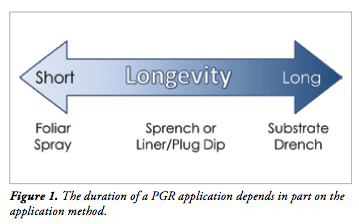
PGR Application Considerations
I am commonly asked what rate, chemical and/or application method of plant growth retardants (PGRs) to apply to various floriculture crops. Responding to such questions is difficult since the answers are so situational. There are different ways to accomplish the same objective, so there is not a single “correct” answer. This article briefly presents some of the considerations when selecting which PGR rate, method and active ingredient to apply.
Application method. Products that contain daminozide (B-Nine and Dazide) are only effective as foliar sprays whereas the other active ingredients are also effective as a sprench, liner/plug dip or substrate drench. Sprays typically provide the shortest-term response, sprenches and dips last for an intermediate period, and drenches are the longest lasting (Figure 1). Generally, foliar sprays or dips are most appropriate for plants that are to be transplanted, such as plugs and liners. Drenches are most suitable when made early to a crop that is already in its final container, and in some cases, late in production for crops that will remain in their containers such as hanging baskets. Drenches are not advised late in a crop if the plants are to be planted into the landscape.
Choice of PGR product. There are several major PGR active ingredients used in floriculture in the United States and all of them have their merits. With the exception of flurprimidol (Topflor), there are multiple products with the same active ingredient, some of which are presented in Figure 2. Generally, the products that have the shortest-lasting response are those that contain daminozide or chlormequat chloride (Citadel and Cycocel). Products that contain ancymidol (Abide and A-Rest) or flurprimidol have relatively moderate strength while those with paclobutrazol (Bonzi, Paczol, and Piccolo) are often even stronger. Generally, the strongest, longest-lasting active ingredient is uniconazole (Concise and Sumagic).
Growers who want a shorter-term response and/or a toning effect may obtain best results with products toward the weaker end of the PGR spectrum. Vigorous plants growing in warm and bright climates may want to choose a PGR that’s toward the middle or stronger end of the spectrum. Having said that, one can be successful with daminozide or chlormequat chloride on vigorous crops, but multiple applications and/or high rates may be need to obtain desired results. Similarly, the strongest PGRs can be used on crops with low vigor, but identification of suitable rates is critical so that crops are not over-regulated.
Application rate. Once a PGR product and application method have been chosen, an appropriate rate has to be determined. This is arguably the most difficult and yet the most important factor. Some of the considerations to guide in a rate choice are in Figure 3. Higher rates are needed when temperatures and light levels are high, varieties are vigorous, and plants are tightly spaced and/or growing in small containers. Lower PGR rates may be needed when other techniques to inhibit extension growth are used, such as a negative DIF or limited phosphorus. Applications that are made early to a crop (proactive applications) generally need lower rates than those made to crops that are already vigorously growing (reactive applications).
There are numerous resources available to help select specific rates, including the PGR labels and company and university websites. Useful input can also be obtained from breeding companies, plant suppliers and university educators. Growers are also encouraged to talk about rates with other growers who have accumulated PGR experience.


 Video Library
Video Library 




















